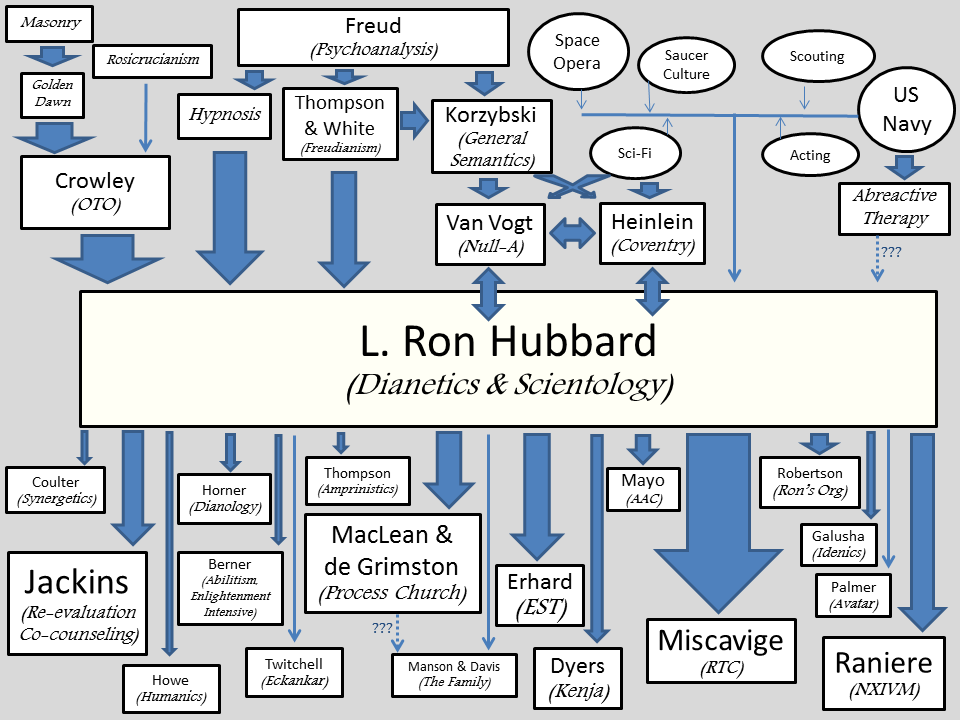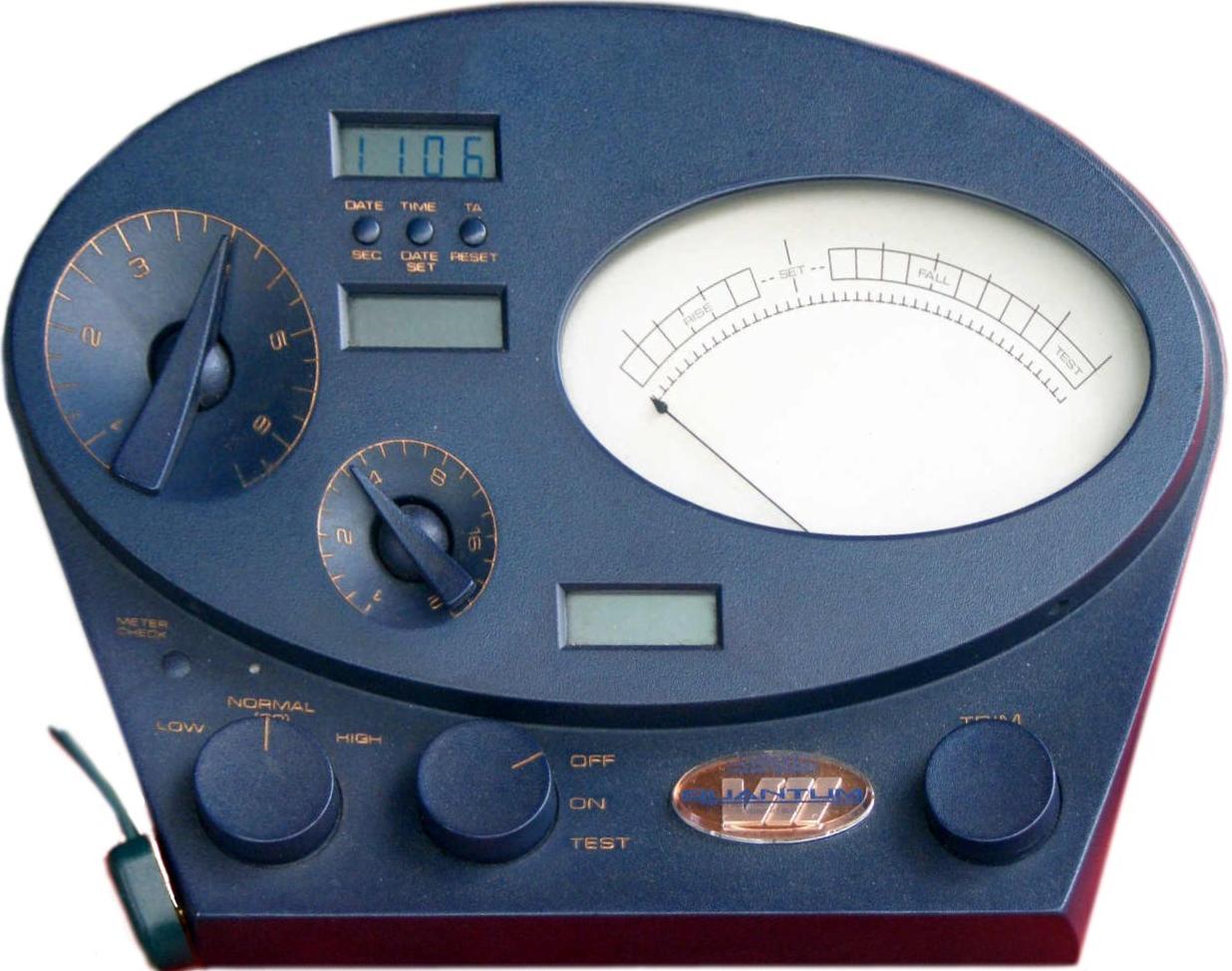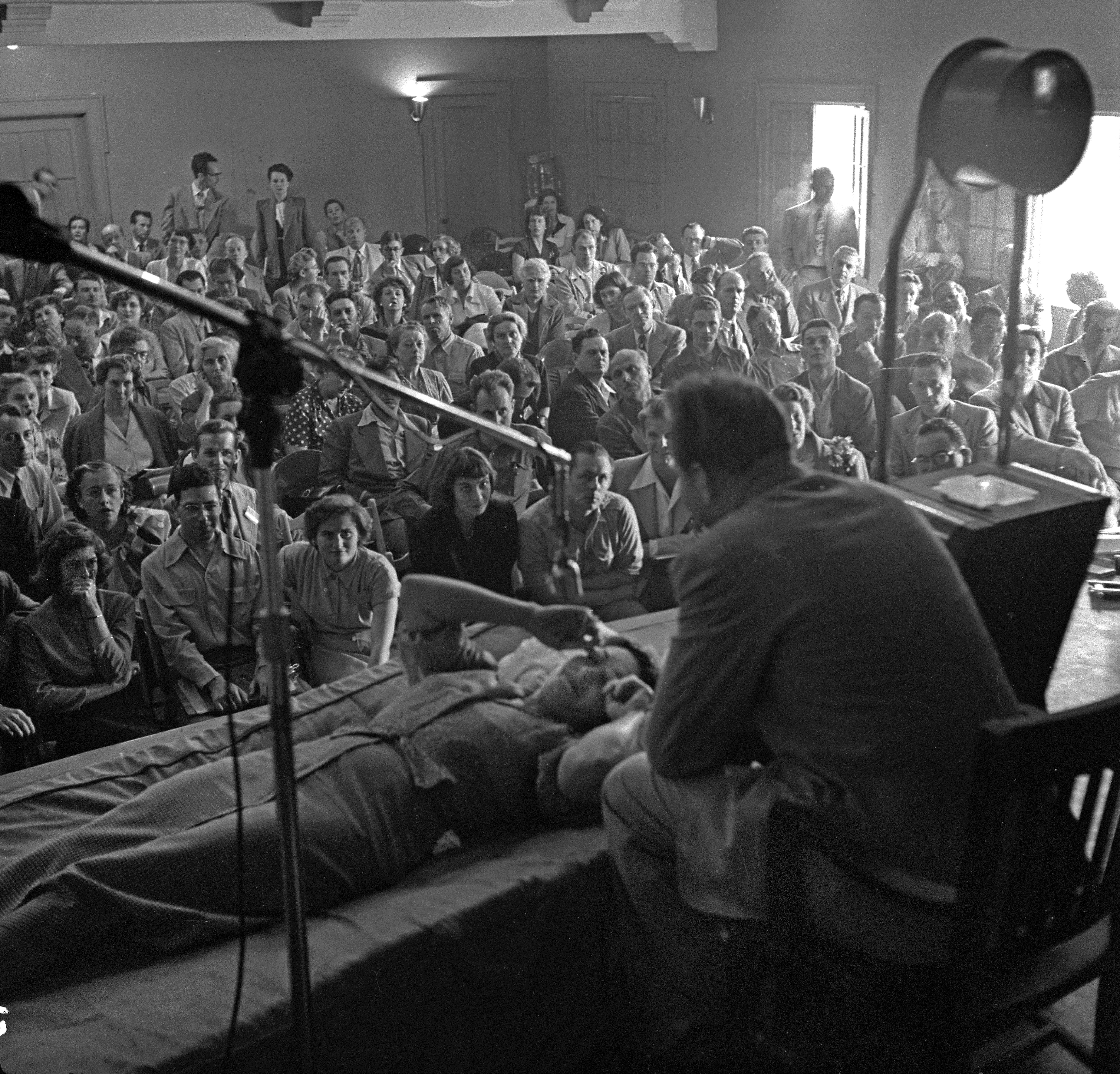|
E-meter
The E-meter, originally the electropsychometer, is an electronic device for displaying the electrodermal activity (EDA) of a human being. It is used for auditing in Scientology and divergent groups. The efficacy and legitimacy of Scientology's use of the E-meter has been subject to extensive litigation and in accordance with a federal court order, the Church of Scientology publishes disclaimers declaring that the E-meter "by itself does nothing," is incapable of improving health, and is used specifically for spiritual purposes. Such devices have been used as research tools in many human studies, and as one of several components of the Leonarde Keeler's polygraph (lie detector) system, which has been widely criticized as ineffective and pseudoscientific by legal experts and psychologists. History Electrodermal activity (EDA) is the changing electrical charges observed on the surface of the skin. EDA meters were first developed in 1889 in Russia, and psychotherapists began u ... [...More Info...] [...Related Items...] OR: [Wikipedia] [Google] [Baidu] |
Volney Mathison
Volney G. Mathison, also known by the pseudonym Dex Volney (August 13, 1897 – January 3, 1965), was an American chiropractor, writer, and inventor of the first E-meter used by the Church of Scientology. Family In 1935, Mathison was married to Jean Darrell, a music librarian for NBC. She died in November 1964. Career Writer In 1921, Mathison wrote the fictional short story "A Phony Phone", which was published in '' Radio News'' edited by Hugo Gernsback. In 1924, he wrote the fictional book ''The Radiobuster: Being Some of the Adventures of Samuel Jones, Deep Sea Wireless Operator''. The book is listed in ''American Fiction, 1901-1925: A Bibliography''. Mathison's story "The Death Bottle" was published in ''Weird Tales'' in March 1925. He also wrote stories which were published under the pseudonym of "Dex Volney". His pieces as "Dex Volney" were of the Western genre, and set in Alaska. According to ''Science-Fiction: The Gernsback Years'', Mathison was "a prolific author" ... [...More Info...] [...Related Items...] OR: [Wikipedia] [Google] [Baidu] |
Scientology Free Stress Test
Scientology is a set of beliefs and practices invented by American author L. Ron Hubbard, and an associated movement. It has been variously defined as a cult, a Scientology as a business, business, or a new religious movement. The most recent published census data indicate that there were about 25,000 followers in the United States (in 2008); around 1,800 followers in England (2021); 1,400 in Canada (2021); and about 1,600 in Australia (2016). Hubbard initially developed a set of ideas that he called Dianetics, which he represented as a form of therapy. This he promoted through various publications, as well as through the Hubbard Dianetic Research Foundation that he established in 1950. The foundation went bankrupt, and Hubbard lost the rights to his book ''Dianetics: The Modern Science of Mental Health, Dianetics'' in 1952. He then recharacterized the subject as a religion and renamed it Scientology, retaining the terminology, doctrines, and the practice of "Auditing (Scientol ... [...More Info...] [...Related Items...] OR: [Wikipedia] [Google] [Baidu] |
Scientology E Meter Blue
Scientology is a set of beliefs and practices invented by American author L. Ron Hubbard, and an associated movement. It has been variously defined as a cult, a Scientology as a business, business, or a new religious movement. The most recent published census data indicate that there were about 25,000 followers in the United States (in 2008); around 1,800 followers in England (2021); 1,400 in Canada (2021); and about 1,600 in Australia (2016). Hubbard initially developed a set of ideas that he called Dianetics, which he represented as a form of therapy. This he promoted through various publications, as well as through the Hubbard Dianetic Research Foundation that he established in 1950. The foundation went bankrupt, and Hubbard lost the rights to his book ''Dianetics: The Modern Science of Mental Health, Dianetics'' in 1952. He then recharacterized the subject as a religion and renamed it Scientology, retaining the terminology, doctrines, and the practice of "Auditing (Scientol ... [...More Info...] [...Related Items...] OR: [Wikipedia] [Google] [Baidu] |
Scientology - The E-Meter
Scientology is a set of beliefs and practices invented by American author L. Ron Hubbard, and an associated movement. It has been variously defined as a cult, a Scientology as a business, business, or a new religious movement. The most recent published census data indicate that there were about 25,000 followers in the United States (in 2008); around 1,800 followers in England (2021); 1,400 in Canada (2021); and about 1,600 in Australia (2016). Hubbard initially developed a set of ideas that he called Dianetics, which he represented as a form of therapy. This he promoted through various publications, as well as through the Hubbard Dianetic Research Foundation that he established in 1950. The foundation went bankrupt, and Hubbard lost the rights to his book ''Dianetics: The Modern Science of Mental Health, Dianetics'' in 1952. He then recharacterized the subject as a religion and renamed it Scientology, retaining the terminology, doctrines, and the practice of "Auditing (Scientol ... [...More Info...] [...Related Items...] OR: [Wikipedia] [Google] [Baidu] |
Scientology
Scientology is a set of beliefs and practices invented by American author L. Ron Hubbard, and an associated movement. It has been variously defined as a cult, a Scientology as a business, business, or a new religious movement. The most recent published census data indicate that there were about 25,000 followers in the United States (in 2008); around 1,800 followers in England (2021); 1,400 in Canada (2021); and about 1,600 in Australia (2016). Hubbard initially developed a set of ideas that he called Dianetics, which he represented as a form of therapy. This he promoted through various publications, as well as through the Hubbard Dianetic Research Foundation that he established in 1950. The foundation went bankrupt, and Hubbard lost the rights to his book ''Dianetics: The Modern Science of Mental Health, Dianetics'' in 1952. He then recharacterized the subject as a religion and renamed it Scientology, retaining the terminology, doctrines, and the practice of "Auditing (Scientol ... [...More Info...] [...Related Items...] OR: [Wikipedia] [Google] [Baidu] |
Auditing (Scientology)
In Dianetics and Scientology, auditing is a process whereby the "auditor" takes an individual through times in their current or past lives with the ostensible purpose of ridding the individual of negative influences from past events or behaviors. Auditing is meant to bring the individual to " Clear" status; thus, an individual being audited is known as a "preclear" or PC. Auditing was invented by L. Ron Hubbard as an integral part of Dianetics, first introduced in 1950. In 1951, auditing also became a core practice of Scientology. The E-meter, a device to measure electrodermal activity, became an integral part of auditing in scientology. According to the Church of Scientology, "one formal definition of auditing is the action of asking a person a question (which he can understand and answer), getting an answer to that question and acknowledging him or her for that answer". Hubbard claimed auditing provided many benefits including unsupported medical and psychological health effect ... [...More Info...] [...Related Items...] OR: [Wikipedia] [Google] [Baidu] |
Dianetics
Dianetics (from Greek ''dia'', meaning "through", and ''nous'', meaning " mind") is a set of pseudoscientific ideas and practices regarding the metaphysical relationship between the mind and body created by science fiction writer L. Ron Hubbard. Dianetics is practiced by followers of Scientology and the Nation of Islam (as of 2010). Dianetics was originally conceived as a branch of psychiatry, which Hubbard would later despise when various psychoanalysts refused his form of psychotherapy. Though it is presented as a form of psychological treatment, Dianetics, and its core concepts including auditing and engrams, have been rejected by psychologists and other scientists from the outset and are unsupported by credible evidence. Background Dianetics divides the mind into three parts: the conscious "analytical mind", the subconscious "reactive mind", and the somatic mind. The goal of Dianetics is to erase the content of the "reactive mind", which practitioners believe interf ... [...More Info...] [...Related Items...] OR: [Wikipedia] [Google] [Baidu] |
Electrodermal Activity
Electrodermal activity (EDA) is the property of the human body that causes continuous variation in the electrical characteristics of the skin. Historically, EDA has also been known as skin conductance, galvanic skin response (GSR), electrodermal response (EDR), psychogalvanic reflex (PGR), skin conductance response (SCR), sympathetic skin response (SSR) and skin conductance level (SCL). The long history of research into the active and passive electrical properties of the skin by a variety of disciplines has resulted in an excess of names, now standardized to electrodermal activity (EDA). The traditional theory of EDA holds that skin resistance varies with the state of sweat glands in the skin. Sweating is controlled by the sympathetic nervous system, and skin conductance is an indication of psychological or physiological arousal. If the sympathetic branch of the autonomic nervous system is highly aroused, then sweat gland activity also increases, which in turn increases skin condu ... [...More Info...] [...Related Items...] OR: [Wikipedia] [Google] [Baidu] |
Electrodermal Activity
Electrodermal activity (EDA) is the property of the human body that causes continuous variation in the electrical characteristics of the skin. Historically, EDA has also been known as skin conductance, galvanic skin response (GSR), electrodermal response (EDR), psychogalvanic reflex (PGR), skin conductance response (SCR), sympathetic skin response (SSR) and skin conductance level (SCL). The long history of research into the active and passive electrical properties of the skin by a variety of disciplines has resulted in an excess of names, now standardized to electrodermal activity (EDA). The traditional theory of EDA holds that skin resistance varies with the state of sweat glands in the skin. Sweating is controlled by the sympathetic nervous system, and skin conductance is an indication of psychological or physiological arousal. If the sympathetic branch of the autonomic nervous system is highly aroused, then sweat gland activity also increases, which in turn increases skin condu ... [...More Info...] [...Related Items...] OR: [Wikipedia] [Google] [Baidu] |
Ronald DeWolf
Ronald Edward "Ron" DeWolf (born Lafayette Ronald Hubbard Jr.; May 7, 1934 – September 16, 1991), also known as "Nibs" Hubbard, was the eldest child of Scientology's founder L. Ron Hubbard by his first wife Margaret Louise Grubb, and highly critical of his father and of the Church of Scientology. Early life In his 1983 interview with '' Penthouse'' magazine, DeWolf said he was born prematurely at after surviving an early abortion attempt; his father constructed a makeshift incubator with a shoe box, later a cupboard drawer, some rubbers, and used blankets and an electric light bulb to keep the baby warm. Relationship with his father Hubbard, Jr. claimed to have helped his father in the early days of Scientology but later rejected his father and Scientology, quitting in 1959 and changing his name to Ronald DeWolf. On November 6, 1982, in a Riverside, California, court, DeWolf sued for control of his father's estate, saying that his father was either deceased or incompet ... [...More Info...] [...Related Items...] OR: [Wikipedia] [Google] [Baidu] |
Mark V E-meter
Mark may refer to: Currency * Bosnia and Herzegovina convertible mark, the currency of Bosnia and Herzegovina * East German mark, the currency of the German Democratic Republic * Estonian mark, the currency of Estonia between 1918 and 1927 * Finnish markka ( sv, finsk mark, links=no), the currency of Finland from 1860 until 28 February 2002 * Mark (currency), a currency or unit of account in many nations * Polish mark ( pl, marka polska, links=no), the currency of the Kingdom of Poland and of the Republic of Poland between 1917 and 1924 German * Deutsche Mark, the official currency of West Germany from 1948 until 1990 and later the unified Germany from 1990 until 2002 * German gold mark, the currency used in the German Empire from 1873 to 1914 * German Papiermark, the German currency from 4 August 1914 * German rentenmark, a currency issued on 15 November 1923 to stop the hyperinflation of 1922 and 1923 in Weimar Germany * Lodz Ghetto mark, a special currency for Lodz Ghetto. ... [...More Info...] [...Related Items...] OR: [Wikipedia] [Google] [Baidu] |






